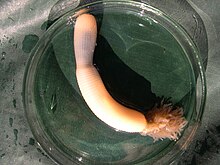
Back قضيبيات Arabic قضيبيات ARZ Priapulidlər Azerbaijani Прыапуліды Byelorussian Приапулиди Bulgarian Priapulida BS Priapúlids Catalan Priapulida CEB Hlavatci Czech Priapswürmer German
| Priapulida Temporal range:
| |
|---|---|

| |
| Priapulus caudatus | |
| Scientific classification | |
| Domain: | Eukaryota |
| Kingdom: | Animalia |
| Subkingdom: | Eumetazoa |
| Clade: | ParaHoxozoa |
| Clade: | Bilateria |
| Clade: | Nephrozoa |
| (unranked): | Protostomia |
| Superphylum: | Ecdysozoa |
| Clade: | Scalidophora |
| Phylum: | Priapulida Théel, 1906[2] |
| Orders | |
Priapulida (priapulid worms, from Gr. πριάπος, priāpos 'Priapus' + Lat. -ul-, diminutive), sometimes referred to as penis worms, is a phylum of unsegmented marine worms. The name of the phylum relates to the Greek god of fertility, because their general shape and their extensible spiny introvert (eversible) proboscis may resemble the shape of a human penis. They live in the mud and in comparatively shallow waters up to 90 metres (295 ft) deep.[3] Some species show a remarkable tolerance for hydrogen sulfide, anoxia and low salinity.[4][5] Halicryptus spinulosus appears to prefer brackish shallow waters.[6] They can be quite abundant in some areas. In an Alaskan bay as many as 85 adult individuals of Priapulus caudatus per square meter has been recorded, while the density of its larvae can be as high as 58,000 per square meter (5,390 per square foot).[7]
Together with Echiura and Sipuncula, they were once placed in the taxon Gephyrea, but consistent morphological and molecular evidence supports their belonging to Ecdysozoa, which also includes arthropods and nematodes. Fossil findings show that the mouth design of the stem-arthropod Pambdelurion is identical with that of priapulids, indicating that their mouth is an original trait inherited from the last common ancestor of both priapulids and arthropods, even if modern arthropods no longer possess it.[8] Among Ecdysozoa, their nearest relatives are Kinorhyncha and Loricifera, with which they constitute the Scalidophora clade named after the spines covering the introvert (scalids).[9] They feed on slow-moving invertebrates, such as polychaete worms.
Priapulid-like fossils are known at least as far back as the Middle Cambrian. They were likely major predators of the Cambrian period. However, crown-group priapulids cannot be recognized until the Carboniferous.[1] 22 extant species of priapulid worms are known, half of them being of meiobenthic size.[10]
- ^ a b Budd, G. E.; Jensen, S. (May 2000). "A critical reappraisal of the fossil record of the bilaterian phyla". Biological Reviews of the Cambridge Philosophical Society. 75 (2): 253–95. doi:10.1111/j.1469-185X.1999.tb00046.x. PMID 10881389. S2CID 39772232.
- ^ Théel, Hjalmar (1905–1906). "Northern and Arctic Invertebrates in the Collection of the Swedish State Museum (Riksmuseum). II. Priapulids, Echiurids etc". Kungl. Svenska Vetenskapsakademiens Handlingar. 40 (4): 8–13.
- ^ Cite error: The named reference
EB1911was invoked but never defined (see the help page). - ^ Oeschger, R.; Janssen, H. H. (September 1991). "Histological studies on Halicryptus spinulosus (Priapulida) with regard to environmental hydrogen sulfide resistance". Hydrobiologia. 222: 1–12. doi:10.1007/BF00017494. S2CID 31342308.
- ^ Kolbasova, Glafira; Schmidt-Rhaesa, Andreas; Syomin, Vitaly; Bredikhin, Danila; Morozov, Taras; Neretina, Tatiana (January 2023). "Cryptic species complex or an incomplete speciation? Phylogeographic analysis reveals an intricate Pleistocene history of Priapulus caudatus Lamarck, 1816". Zoologischer Anzeiger. 302: 113–130. Bibcode:2023ZooAn.302..113K. doi:10.1016/j.jcz.2022.11.013.
- ^ The phylogeny, classification and zoogeography of the class Priapulida. II. Revision of the family Priapulidae and zoogeography of priapulids
- ^ Margulis, Lynn; Chapman, Michael J. (19 March 2009). Kingdoms and Domains: An Illustrated Guide to the Phyla of Life on Earth. Academic Press. ISBN 978-0-08-092014-6.
- ^ "Ancestor of arthropods had the mouth of a penis worm".
- ^ Dunn, C. W.; Hejnol, A.; Matus, D. Q.; Pang, K.; Browne, W. E.; Smith, S. A.; Seaver, E.; Rouse, G. W.; Obst, M. (10 April 2008). "Broad Phylogenomic Sampling Improves Resolution of the Animal Tree of Life". Nature. 452 (7188): 745–749. Bibcode:2008Natur.452..745D. doi:10.1038/nature06614. PMID 18322464. S2CID 4397099.
- ^ Giere, Olav (November 2008). Meiobenthology: The Microscopic Motile Fauna of Aquatic Sediments. Springer. ISBN 978-3-540-68661-3.
© MMXXIII Rich X Search. We shall prevail. All rights reserved. Rich X Search